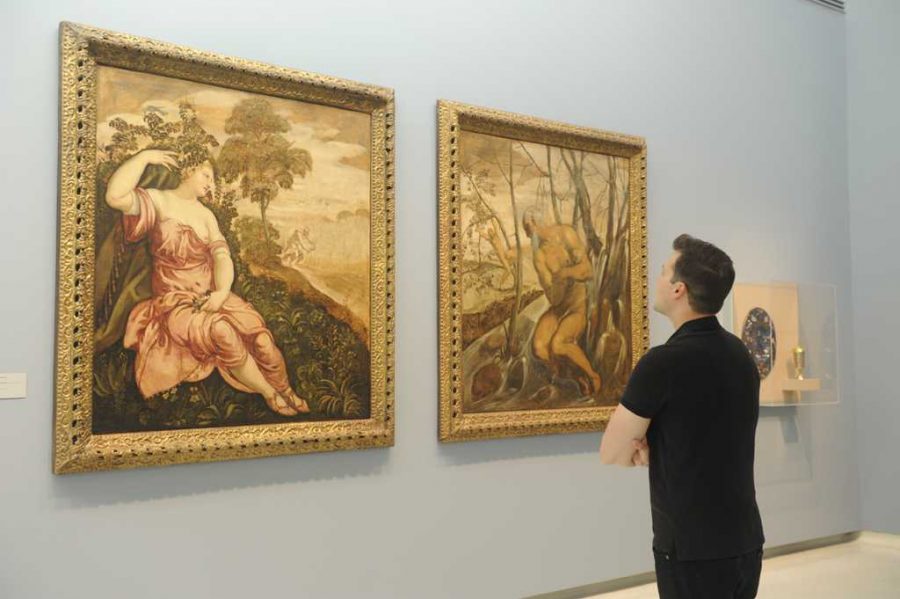Lexi Kennell / Staff Writer
Carnegie Museum of Art
With multiple exhibits in circulation, it’s hard not to spend hours soaking up the original works of Claude Monet and Jean Dunand in the Carnegie Museum of Art.
The Carnegie Museum of Art is located on Forbes Avenue, across the street and a few blocks down from the Cathedral of Learning. The museum is connected to the Carnegie Museum of Natural History, and both offer free admission for Pitt students with valid ID during the fall and spring semesters.
The museum is currently holding seven exhibits, both national and local, including Associated Artists of Pittsburgh’s 105th Annual Exhibition and Hot Metal Modern: Design in Pittsburgh and Beyond. The museum also presents a collection of work from every artistic movement, displayed in chronological order.
In addition to weekday hours, the museum also offers events at night, including a monthly party held on the third Thursday of every month, appropriately titled, Third Thursdays. The theme changes every month, but the museum always offers free-range of all current exhibits and an unforgettable atmosphere. With college ID, tickets cost $5 instead of $10.
Nick Mullen / Staff Writer
Carnegie Museum of Natural History
The Carnegie Museum of Natural History is a sprawling testament to Pittsburgh’s industrious past. The Carnegie Museums, founded by industrialist and philanthropist Andrew Carnegie in 1896 and located in the heart of Oakland, houses extensive collections, exhibit rooms, offices, and research space.
Among the ornate marble columns and large, detailed murals, the museum houses an impressive and diverse collection of exhibits, educating visitors on everything from dinosaurs, to animals and human development. The museum is well known for its expansive and historic collection of dinosaurs, including Dippy, a Diplodocus carnegii, named for Andrew Carnegie, who funded an expedition in 1899 which unearthed one of the creatures. Also on display are various exhibits about human history and wildlife, including exhibits featuring Ancient Egypt, African and North American wildlife, the Arctic and Population Impact, an exhibit that features and educates about the impact humans have on our surroundings.
The museum also features an “After Dark” program, where, for guests 21 and older, the museum opens after dark with an open bar and live music, designed to put a new spin on a classic museum experience. Like many of Pittsburgh’s attractions, the Carnegie Museum of Natural History has its roots with Pittsburgh’s old industrial past, but like the city now, is a dynamic and evolving world-class institution with plenty to see and do.
Ian Flanagan / Culture Editor
The Andy Warhol Museum
A testament to one Pittsburgh’s most famous natives, The Andy Warhol Museum, located on the North Shore, is well worth a visit, despite its distance from the University.
Consisting of seven floors chronicling the eccentric and inspired career of the pop art giant, the museum offers extensive insight into Warhol’s life, from his humble art school origins to his work with The Velvet Underground and Exploding Plastic Inevitable, up to his untimely death following recovery from gallbladder surgery at 58.
The museum features 900 paintings and about 100 sculptures — among many other prints, drawings and photographs — and there is even a room of touch screen video players that contain upwards of 4,350 of Warhol’s experimental films and related video projects.
Erected in 1989, the museum now welcomes over 100,000 annual visitors, and there is an undeniable wealth of artifacts from Warhol’s life — as something of a hoarder, many of his boxed-up possessions are in rotation for spectating beyond his iconic work.
Amongst his more obscure and bizarre projects — one floor features a video of Warhol eating a Burger King meal on a constant loop — there are his classic works like “Campbell’s Soup Can” and his painted celebrity portraits, making the familiar and the unfamiliar both something to discover firsthand.
Ian Flanagan / Culture Editor
The Mattress Factory
The site for works by over 650 artists, the Mattress Factory — which has been around for nearly 40 years in Central Northside — is one of Pittsburgh’s most idiosyncratic museum locations.
With a reputation for “alternative art forms,” the museum is known for its many contemporary works that are integrated with the building. For instance, a floor is devoted to navigating through the dark towards separate features — one involves coming to a room where from the entrance looks like a blue screen ahead of you, yet as you move closer, you realize the screen opens into another blue-lit room.
Plenty of the bizarre and experimental pieces on display have a disorienting or illusory aspect. This includes the 17 permanent installations that are a growing staple of the Mattress Factory since 1981. New local and national artists are given the spotlight as well — the museum has expanded in time to several other locations for gallery space.
Beyond spectating the museum functions as a research and development lab for artists, and The Mattress Factory Education Department has programming for the young and old — 20,000 people annually — throughout the year. Though the property’s unconventional take on the idea of browsing a museum may seem vexing from a distance, a curious journey examining the Mattress Factory up close is altogether rewarding.



